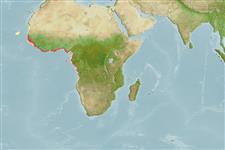Common names from other countries
Environment: milieu / climate zone / depth range / distribution range
Sinh thái học
Biển; Thuộc về nước lợ gần đáy; Mức độ sâu 10 - 70 m (Ref. 10799). Tropical; 21°N - 18°S, 27°W - 14°E (Ref. 57343)
Eastern Atlantic: Senegal to Angola (Ref. 57402). Also reported from Mauritania (Ref. 10799) and Cape Verde (Ref. 27000). Reported from Cuba based on a single specimen; no other specimens taken from the western Atlantic (Ref. 57343).
Length at first maturity / Bộ gần gũi / Khối lượng (Trọng lượng) / Age
Maturity: Lm 15.0 range ? - 17 cm
Max length : 35.0 cm TL con đực/không giới tính; (Ref. 57402); common length : 25.0 cm TL con đực/không giới tính; (Ref. 3659)
Các tia vây lưng cứng (tổng cộng) : 9; Các vây lưng mềm (tổng cộng) : 14 - 18; Tia cứng vây hậu môn: 3; Tia mềm vây hậu môn: 28 - 30. Diagnosis: detached pectoral filaments very long, exceeding body length; base of anal fin much longer than base of 2nd dorsal fin; body moderately elongate and compressed, its height comprised 3.0-3.4 in standard length; snout very short, blunt and prominent; mouth inferior; maxillary bone strongly widened at its end, reaching largely past eye; 2 widely separated dorsal fins, 1st with 8 flexible spines, 2nd with 1 spine and 14-18 soft rays; anal fin base much longer than 2nd dorsal fin base; pectoral fin inserted very low on body; threadlike filaments, 5 in number, 4 of them longer than total length of fish; scales ctenoid; head scaly (Ref. 57402).
Coloration: body uniformly silvery, greyish on back, shading to whitish ventrally; fins tinged with yellow (Ref. 57402).
Occurs over sandy (Ref. 2683) and muddy bottoms in shallow waters (Ref. 57343), frequently in brackish waters (Ref. 57343, 57402) and estuaries (Ref. 57402). Carnivorous (Ref. 57402), feeds on fish and shrimps (Ref. 28587).
Life cycle and mating behavior
Maturities | Sự tái sinh sản | Spawnings | Egg(s) | Fecundities | Ấu trùng
Motomura, H., 2004. Threadfins of the world (Family Polynemidae). An annotated and illustrated catalogue of polynemid species known to date. FAO Spec. Cat. Fish. Purp. Rome: FAO. 3:117 p. (Ref. 57343)
IUCN Red List Status (Ref. 130435)
CITES (Ref. 128078)
Not Evaluated
Threat to humans
Harmless
Human uses
Các nghề cá: tính thương mại cao
Các công cụ
Special reports
Download XML
Các nguồn internet
Estimates based on models
Preferred temperature (Ref.
115969): 20.2 - 27.9, mean 25.8 (based on 70 cells).
Phylogenetic diversity index (Ref.
82804): PD
50 = 1.0000 [Uniqueness, from 0.5 = low to 2.0 = high].
Bayesian length-weight: a=0.00398 (0.00237 - 0.00669), b=3.13 (2.98 - 3.28), in cm Total Length, based on LWR estimates for this species & (Sub)family-body (Ref.
93245).
Mức dinh dưỡng (Ref.
69278): 3.6 ±0.57 se; based on food items.
Thích nghi nhanh (Ref.
120179): Chiêù cao, thời gian nhân đôi của chủng quần tối thiểu là dưới 15 tháng (K=0.72).
Fishing Vulnerability (Ref.
59153): Low to moderate vulnerability (31 of 100).
Climate Vulnerability (Ref.
125649): High to very high vulnerability (75 of 100).
